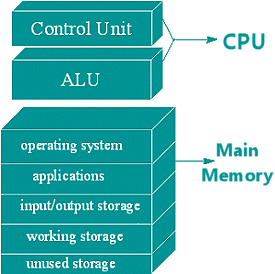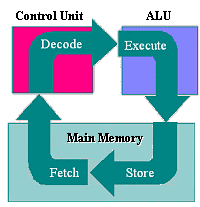Jan's Computer Basics:
Processing: CPU
The CPU, or Central Processing Unit, is the part of the computer where work gets done. Many computers today have more than one processing chip, resulting in more complex but faster processing.
Main Memory stores the commands that the CPU executes and the results.

![]() Click on each of the labels in the diagram. You'll be shown an explanation below.
Click on each of the labels in the diagram. You'll be shown an explanation below.
Explanation:
Control Unit
This is the part of the computer that controls the Machine Cycle. It takes numerous cycles to do even a simple addition of two numbers.
The Machine Cycle |
Fetch - | get an instruction from Main Memory |
| Decode - | translate it into computer commands | |
| Execute - | actually process the command | |
| Store - | write the result to Main Memory |
ALU
stands for Arithmetic/Logic Unit
This is the part that executes the computer's commands.
A command must be either a basic arithmetic operation:
+ - * /
or one of the logical comparisons:
> < = not =.
Everything else has to be broken down into these few operations. Only one operation is done in each Machine Cycle.
The ALU can only do one thing at a time but can work very, very fast.
Operating System
This is the instructions that the computer uses to tell itself how it "operates". It's the answer to "Who am I and what can I do?"
Some common operating systems are DOS, various versions of Windows, OS/2, UNIX, LINUX, System 7. These all behave in very different ways and have different hardware requirements. So they won't all run on all machines.
Only the parts of the operating system that are currently being used will be loaded into Main Memory.
Applications
These are the various programs that are currently running on the computer.
By taking turns with the Machine Cycle, modern computers can have several different programs running at once. This is called multi-tasking.
Each open application has to have some data stored in Main Memory, even if the application is on rest break and is just sitting there. Some programs (graphics programs are notorious for this) require a lot of the Main Memory space, and may not give it up even if they are shut down! Rather rude, actually!!
Input/Output Storage
When you enter new data, the keystrokes must be stored until the computer can do something with the new data.
When you want data printed out or displayed, it must be stored somewhere handy first.
Working Storage
The numbers and characters that are the intermediate results of computer operations must be stored until the final values are calculated. These values "in progress" are kept in temporary locations.
For example, if the computer is adding up the numbers 3, 5, and 6, it would first add 3 to 5 which yields a value of 8. The 8 is stored in working storage. Then the 8 and 6 are added and the new value 14 is stored. The value of 14 is now available to be displayed on the screen or to be printed or to be used in another calculation.
Unused Storage
One hopes that there is always some storage space that is not in use.
If space runs out in Main Memory, the computer will crash, that is, stop working.
There are programs that sense when space is getting short and warn the user. The user could then close some of the open applications to free up more space in Main Memory. Sometimes the warning is too late to prevent the crash. Remember that all the data in Main Memory vanishes when the power goes off. Thus a crash can mean a lot of lost work.
CPU
stands for Central Processing Unit
This is the part of the computer that does the "thinking."
Main Memory
This is where the computer stores the data and commands that are currently being used.
When the computer is turned off, all data in Main Memory vanishes. A data storage method of this type is called volatile since the data "evaporates."
Note on the left the various kinds of data that are stored.
The CPU can fetch one piece of data in one machine cycle.
